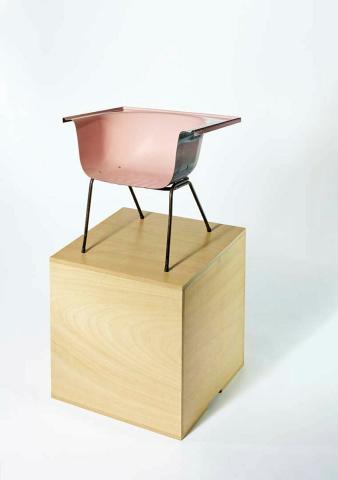RINGHOLT, Stuart; Untitled (wing chair - pink)
By Peter McKay
Stuart Ringholt’s works are disorienting. They eschew our expectations and challenge our inclination to observe broadly accepted social norms. Although many of us would prefer not to place ourselves in compromising positions, Ringholt’s public workshops - for which he invites others to join him in situations conceived to cause personal embarrassment and confrontation - have been a surprise hit. These include his Anger Workshop, commissioned as part of the 2008 Biennale of Sydney, which invited people to explore their emotions and humanity together; and his more recent naturist art museum tours at Brisbane’s Institute of Modern Art in 2011, exploring the dynamics of nude art appreciation, or rather, art appreciation in the nude.
Ringholt’s sculptural works operate in much the same way, presenting entirely familiar objects in seemingly functional, yet mind-numbingly illogical, new materialisations. In this group of recent Collection acquisitions, a bathtub cut in half has become a wing chair; Coca-Cola and Foster’s Lager cans have become aerosols, in the mode of pest-control or deodorant sprays; and fabricated cigarettes and pencils have ends with no beginnings. In Ringholt’s world, everyday objects are somewhat confrontational. The modifications he makes to these contradict what we know about them and apparently mock our ability to understand why and how they function. So convincing are these simple, seamless alterations that they can potentially menace our sense of self-worth, inspiring feelings of incomprehension, inadequacy or instability.
Ringholt’s objects are witty plays on the tradition of the ‘readymade’. Untitled (wing chair - pink) 2009, in particular, dryly continues modern art’s penchant for bathroom humour, which began with Marcel Duchamp’s upturned urinal signed ‘R.Mutt “Fountain” 1917’. Similarly insulting, Ringholt’s chair offers itself as a throne for a fool, though it is meant with some generosity. After all, a wing chair is typically a dignified and comfortable furniture piece that displays a level of taste and social standing, though this particular example is less likely to insulate the sitter’s ego.
We can react in a number of ways when we encounter a situation that contradicts, frustrates or challenges our expectations. A positive response might be excitement, amusement or curiosity, while a negative response might be aggression, denial, fear or resentment. In this light, we can better understand Ringholt’s therapeutic intent. Humans are wonderful at rationalising but are not always rational beings; these sculptures can present us with a device that allows us to reflect on how we behave when we are ‘caught out’. They ask, can we use such instances to build our capacity to engage with the world in a positive regard? Do we need to find ways to explain - to ourselves and to others - that we are not fools? And would we perhaps be better served by accepting our fallibility with grace and good humour, when presented with the opportunity?
Peter McKay, Artlines 1-2012, p.42.
